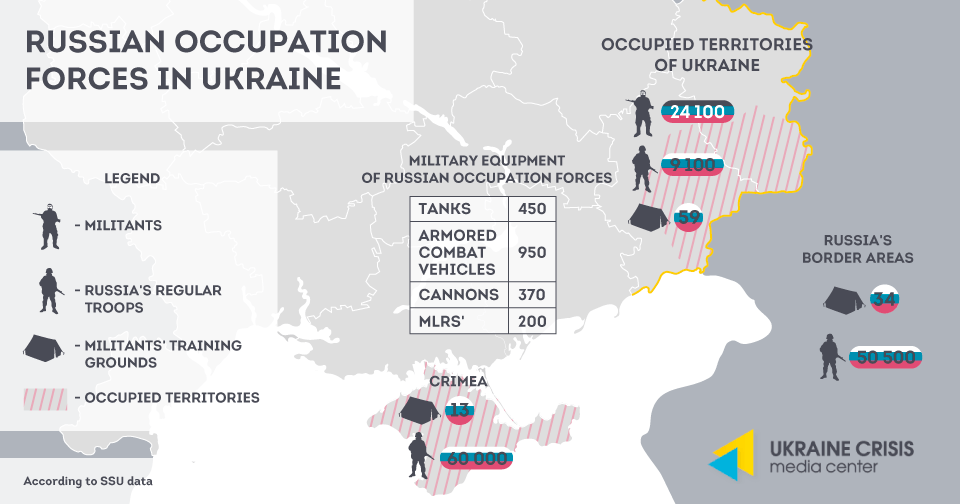Deputy Head of the Presidential Administration Andriy Taranov and Head of the Security Service Vasyl Hrytsak presented what they described as irrefutable evidence of Russian Armed Forces’ participation in hostilities in the Donbas Region and violation of the Minsk agreements to journalists. The evidence was gathered by Ukrainian intelligence and confirmed by the intelligence of Ukraine’s international partners.
Detailed documentary materials were presented which confirm a constant and deliberate violation of the main provisions of the Minsk agreements by Russian occupation forces concealed by statements of Russia about the necessity of a peaceful resolution to the conflict, said the officials.
These materials were also presented today to the diplomatic corps present in Ukraine.
According to Ukrainian security officials, a radical change in Russian participation in hostilities in the east of Ukraine took place in summer 2015. The Ukrainian Armed Forces are now confronting not mixed Russian terrorist groups, but structured military units of the Russian regular army. Nevertheless, Putin’s regime keeps denying Russia’s involvement in the conflict in the east of Ukraine as well as the participation of Russian Armed Forces and special services.
Thus, according to the Head of the Security Service of Ukraine, a powerful occupation ground formation has been established in the occupied territory of the Donbas Region by the military leadership of Russia. The core of this formation is represented by two army corps that are ready to conduct active offensive operations, but are undergoing training for defensive operations. The general operational management of the formation, as well as the coordination of its actions, are directly performed by the General Staff of the Russian Armed Forces. The staff of the Southern Military District and the 12th command reserve are in charge of force generation, recruitment, training, and logistics of the Russian occupation troops in the Donbass Region, stated the officials. The staff of the 1st and the 2nd Army Corps (AC) directly manage the actions of their subordinate units and are located respectively, with the 1st AC located in Donetsk and the 2nd AC located in Luhansk.
Thus, ATO forces in the Donbas confront the full-fledged military units of the Armed Forces of the Russian Federation, where a large number of heavy weapons and military equipment are concentrated. The staggered accumulation of large amounts of petroleum, oil, and lubricants, as well as ammunition is being undertaken, presumably for active offensive operations, which would be supported by bringing additional units of the Armed Forces of the Russian Federation into the territory of Ukraine according to the plan of the General Staff of the Russian Armed Forces.
The Deputy Head of the Presidential Administration and the Head of the Security Service emphasized that the intensification of hostilities in eastern Ukraine coincides with the intensification of terrorism and sabotage, as well as reconnaissance groups of the enemy in the northern regions of Ukraine, and in particular in the Odessa and Mykolaiv Regions. However, the day-to-day activity of the special services of Ukraine prevents the Russian terrorist leaders’ plans from becoming reality, said the representatives.
According to them, the organizational and staff structure of the formations and units of the two army corps is based on Russian mobilization patterns. The territorial defense battalion is comprised of volunteers from the occupied territories of Ukraine and mercenaries from Russia and other countries. Russian generals and officers perform their tasks in the occupied territories of Ukraine on a rotational basis with replacement after a period of 3 to 6 months.
Particular attention is drawn to the fact that since early 2015, all Russian officers and generals involved in the hostilities in the east of Ukraine also perform the remote management of the Russian occupation forces from Russian territory and have corresponding cover-surnames to sign military documents. These were made up to conceal Russian servicemen and avoid criminal responsibility in the future.
This practice was applied by the Soviet Union in Spain from 1936 – 1940 when the Red Army generals had cover-surnames during their engagement there.
In general, the Russian occupation forces’ numbers are as follows in the territory of Ukraine: over 33 thousand persons and approximately nine thousand servicemen of units of the Russian regular army. In total, the military reserve consists of 21 tactical groups of the Armed Forces of the Russian Federation (15 battalion and six company groups).
In addition, 53 tactical groups from the Armed Forces of Russia (39 battalion and 14 company groups) are concentrated near the borders of Ukraine, numbering 50.5 thousand servicemen.
Satellite images of the concentration of Russian occupation forces in the territory of Ukraine represent irrefutable evidence, stated the government officials.
To strengthen the formations of the Russian occupation forces in eastern Ukraine, Russia secretly brings personnel, equipment, and logistical tools into Ukrainian territory, stated the representatives.
The Ukrainian intelligence has materials documenting Russian occupation forces’ violation of the basic provisions of the Minsk agreements related to the withdrawal of heavy weapons.
Thus, irrefutable satellite images demonstrates the presence of over 100 mm caliber artillery systems in firing positions at the 25 kilometer zone along the contact line of the parties.
According to available data, 20 artillery batteries of the Russian occupation forces, which are armed with more than 120 guns and restricted caliber howitzers, are involved in alert activities and fire strikes on the ATO positions.
The average intensity of shelling of ATO forces’ positions by the Russian occupation forces is approximately 60 times per day. Meanwhile, the number of shelling incidents is increasing significantly in preparation for and during the offensive operations of the enemy as well as the day before the talks in the Minsk and Normandy format.







